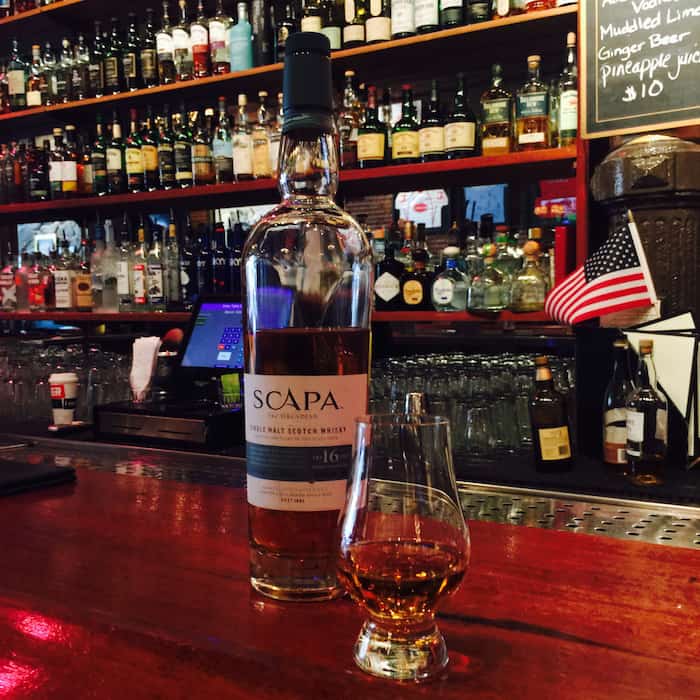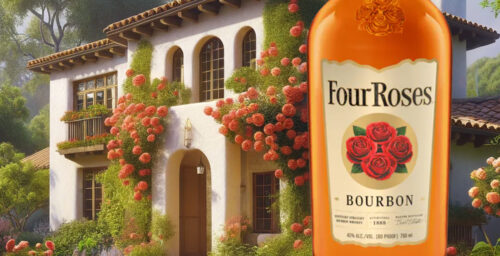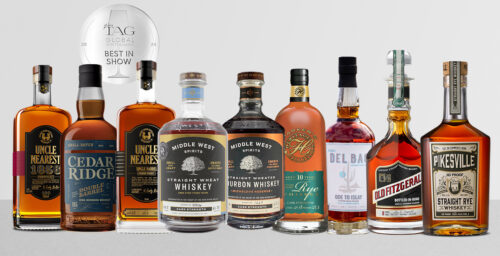Well, by now most enthusiasts of Scapa 16 Year Old whisky know that it has been discontinued. Although this quirky standby has never been a favorite go-to dram for me, it does occupy a place of fondness in my heart.
Along with Highland Park distillery, Scapa is located in the far north of Scotland, on the same chain of islands where Doctor Frankenstein created his infamous monster. The Orkneys inspire independent thinking, to be sure. And the folks who live there have an accent with a bit of Old Norse hiding something between their vowels and consonants.
Like an Orcadian accent, whisky-making in the far north of Scotland is slow to change, and that’s a good thing. Our editor in chief hit the hobnail on the head in a past article he wrote about Scapa, when he noted the distillery “[s]ports a unique barrel-shaped Lomond wash still that’s said to be the only remaining working Lomond in the Scotch whisky industry today.” For me, this old style of craftsmanship results in a very unique tasting dram.

In many other parts of Scotland, whiskies are beginning to taste similar to each other, regardless of how physically isolated their production facilities might be. Part of this cultural homogenization is due to big corporations taking over the trade, and standardizing technologies. But part of it also has to do with the way whisky makers communicate so effortlessly these days, especially over the Internet.
It’s refreshing to sample the wares of stubborn old throwbacks like Scapa in the whisky world. Another distillery in the same eccentric class is Edradour; this quaint little operation also makes use of only one wash still and one spirit still to produce very unique tasting single malt scotch whisky.
A Taste All Its Own
I would venture to say that Ye Olde Scapa 16 was underrated by critics, generally speaking. It offered a strange tincture mixed in with biscuit, short bread, toffee, autumn leaves on the forest loam after a rain, moss, and nougat. There was also a cinnamon (woody) note along with the loamy note in there, as well.
Even though none of the Scapas use peat-dried barley, a little peaty flavor sneaks into water used to make the whisky, even though it is transported through pipes to avoid too much “brown from the ground” on site.
E150a colorant was added to the Sixteen. Believe it or not, I maintain that I can taste a hint of the stuff, but oh well. A great many well-regarded whiskies are guilty of the same (somewhat odious) sin.
I’ve always wondered how Scapa would taste with a touch of Orcadian peat added to the mix. Unlike Highland Park, the distillery doesn’t use it. Oh well, again.
So, no . . . Scapa 16-Year-Old was not “big” anything. But it was a refreshing change of pace from the madding crowd of Speyside wannabees, sherry bombs, and phenol-fueled bonfires. An understated gentleman, it filled a unique niche with grace and aplomb. Sixteen years of age were certainly respectable for an official bottling, especially by today’s standards.
My ex-wife liked Scapa 16-Year-Old, and that’s saying something. She is not a whisky person, and prefers wine–and not all that much wine, actually.
Like the more brazen Scapa 12-Year-Old, which came before, Scapa 16-Year-Old will be dearly missed! I shall morn the loss of this fading Orcadian beacon of wyrd. Unfortunately, I never got the opportunity to taste Scapa 12-Year-Old before it vanished off the face of the earth. So . . . if anyone has a dram of the twelve to spare, then who’s your best friend? I am who I am!
Value to Collectors
Most collectors will say that there is no point in salting away a bottle of the Sweet Sixteen, but I’m not so sure. It’s still available in parts of my home state of Oregon. For less than one ninety dollars, I might keep one for a rainy day, or an advantageous trade with a friend, long after it goes the way of the dodo bird (extinct). After all, many folks tend to look back nostalgically on things they can no longer acquire, and this can result in inflated estimations of worth.
Currently, Scapa distillery only offers an NAS called Skiren. Although I’ve never tasted this newbie, the whisky is rumored to be more fruity that its older teen brother. And, of course, one can always hunt down independent bottlings of Scapa. I’m still punching myself for passing on a rare cask strength edition of Scapa a few years ago on The Whisky Barrel.
Some Final Thoughts
“Peat sorrow” in the title of this article might be a little misplaced since Scapa does not use barley dried with peat. Still, I just couldn’t resist the Shakespearean pun. And in all fairness, a little peat did sneak into the wash of Scapa 16-Year-Old courtesy of peat-enriched local water used to make this fantastically weird elixir.
As the present becomes the future, and the past takes on a nostalgic tint of dappled-drawn dusk, I shall treasure the uniqueness that was Ye Olde Scapa. After all, I’m from Portland, and we Portlanders are famous for liking to “keep it weird.”








